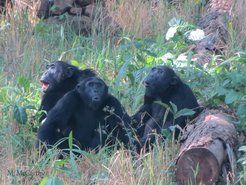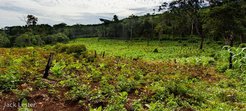Chimpanzees coping with forest loss
A genetic survey finds an unexpectedly large population of chimpanzees in forest fragments
By collecting faecal samples and analysing them genetically a team of researchers found three times more chimpanzees than expected in a series of patchy forest fragments near villages in Uganda. This finding suggests that chimpanzees can cope with habitat degradation better than expected, at least in the short term, but also highlights the importance of conservation strategies focused on protecting chimpanzees outside established national parks or reserves.

The Budongo and Bugoma Forest Reserves in Uganda are each over 400 km2 in size and harbor approximately one-quarter of the estimated 5,000 remaining chimpanzees in Uganda. Between these two reserves lies an unprotected area more than twice their combined size. This patchy habitat composed of forests, villages, agricultural lands and natural grasslands is also a known habitat for chimpanzees, but counting them presents a number of challenges. Direct monitoring is a lengthy process, counting nests can be inaccurate, while the use of camera traps and acoustic monitoring is still in its infancy.
A team led by Maureen McCarthy of the University of Southern California in Los Angeles, USA, and Linda Vigilant of the Max Planck Institute for Evolutionary Anthropology in Leipzig, Germany, spent 15 months carrying out ‘genetic censusing’ to come up with an estimate of the number of chimpanzees in the corridor region. This involved collecting 865 chimpanzee faecal samples across 633 km2 and genetically analysing them to identify the presence of 182 different chimpanzees. Using information on how often individuals were re-sampled, they estimated the total population size of the area to be either 256 or 319 chimpanzees, depending on the calculation used. This suggests the presence of at least nine communities containing a minimum of eight to 33 individuals each. “These figures are more than three times greater than a previous estimate of around 70 chimpanzees, a number based on small-scale nest count surveys”, says Vigilant.
The authors say that it is highly improbable that the unexpectedly high estimates are evidence of population growth since the time of the previous nest count census. This is due to the long interval between chimpanzee births and the high rate of habitat loss throughout the region over the intervening years. The substantially higher estimates instead likely reflect the improved accuracy of the genetic censusing approach over nest count approaches.

Lead author McCarthy adds: “Our results are notable given the fragmentation of forests in this region and the high human population density. The forest cover in Uganda has decreased by 37% in 20 years. The presence of the chimpanzees in distinct communities suggests that they are remarkably resilient and can survive even in degraded habitats if they are not hunted. However, their future survival remains uncertain if protection is not afforded to them and habitat loss continues unabated.” The well-known behavioral flexibility of chimpanzees may have aided their survival, as they are capable of incorporating new and even human-cultivated foods into their diets and adopting more aggressive behaviors to mitigate human threats.
“Our study demonstrates that even unprotected and degraded habitats can have high conservation value”, says McCarthy. “Though national parks and other protected areas are typically prioritized in conservation planning, unprotected areas should also be considered vital for conservation if they are highly valuable as wildlife corridors that harbor endangered species and maintain gene flow among larger populations of such species.” The authors predict that a corridor enhancement project in this region would positively impact 30% of Uganda’s total chimpanzee population, including the chimpanzee populations of both Budongo and Bugoma Forests and the region between them.
JW, SJ, MM, LV/HR

